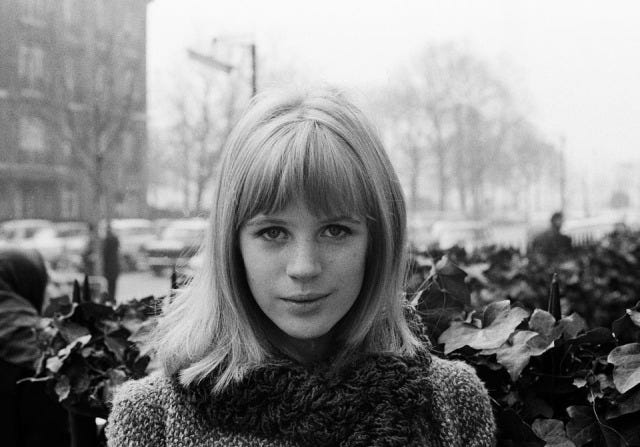
Marianne Faithfull was an English singer, songwriter, and actress whose career spanned six decades. Rising to fame in the 1960s as part of the British Invasion, she became an icon of the era with her ethereal voice, striking beauty, and association with the Rolling Stones. However, her life was also marked by personal struggles, substance abuse, and a remarkable reinvention that solidified her status as one of the most enduring and respected artists in music history.
Early Life and Influences
Marianne Evelyn Gabriel Faithfull was born in Hampstead, London, on December 29, 1946, the daughter of Major Robert Glynn Faithfull, a British Army officer and college professor, and Eva von Sacher-Masoch, Baroness Erisso, an Austro-Hungarian aristocrat and former ballet dancer. Her maternal lineage traced back to the infamous Leopold von Sacher-Masoch, the author whose name inspired the term “masochism.”
Faithfull spent much of her early childhood in Reading, Berkshire, where she attended St Joseph’s Convent School. It was there that she developed an interest in literature, music, and performance. Raised with an appreciation for art and culture, her upbringing was a mix of British discipline and European romanticism, shaping her unique artistic sensibilities.
Breakthrough in the 1960s
Marianne Faithfull’s entry into the music industry was almost accidental. In 1964, she attended a party hosted by the Rolling Stones’ manager, Andrew Loog Oldham. It was there that Oldham recognized her potential and encouraged Mick Jagger and Keith Richards to write a song for her. The result was “As Tears Go By,” a melancholic ballad that became an instant hit, reaching No. 9 on the UK charts and making Faithfull a household name.
.
.
Following the success of her debut, Faithfull released a string of singles, including “Come and Stay with Me,” “This Little Bird,” and “Summer Nights,” which established her as a leading female artist of the British Invasion. Her self-titled debut album in 1965 showcased her delicate vocals and folk influences, but it was her association with the Rolling Stones that cemented her place in rock history.
High Society and Relationship with Mick Jagger
Marianne Faithfull’s relationship with Mick Jagger began in 1966, and the two quickly became one of the most glamorous couples of the 1960s. She became deeply immersed in the rock ‘n’ roll lifestyle, inspiring songs such as “Wild Horses” and “You Can’t Always Get What You Want.” Faithfull also co-wrote “Sister Morphine,” which would later appear on the Rolling Stones’ seminal album Sticky Fingers.
However, with fame came scandal. In 1967, Faithfull was at Keith Richards’ Redlands estate when police raided the premises for drugs. The discovery of Faithfull, barely clothed in a fur rug, became a media sensation and led to her being labeled as the “bad girl” of the British music scene.
Decline and Addiction in the 1970s
By the early 1970s, Marianne Faithfull’s life took a dark turn. Her breakup with Jagger in 1970 left her devastated, and she spiraled into heroin addiction. She lost custody of her son, Nicholas, became homeless for a period, and spent years struggling with substance abuse.
Despite her personal turmoil, she attempted to continue her career. She dabbled in acting, appearing in films such as The Girl on a Motorcycle (1968) and Hamlet (1969), but her addiction overshadowed her talent. By the mid-70s, she had largely faded from the public eye, living in relative obscurity.
Reinvention: The Triumph of “Broken English”
Marianne Faithfull’s remarkable comeback came in 1979 with the release of Broken English. Unlike her earlier work, this album was raw, edgy, and brutally honest, reflecting the years of hardship she had endured. Her voice, once angelic, had deepened into a raspy, emotive instrument that perfectly suited the dark, post-punk-infused sound of the album.
Tracks like “The Ballad of Lucy Jordan” and the title song “Broken English” redefined her as an artist, earning her critical acclaim and a new generation of fans. The album was a commercial success and marked the beginning of a new era for Faithfull as a deeply introspective, avant-garde artist.
.

.
Continued Evolution in the 1980s and 1990s
Following the success of Broken English, Faithfull continued to release thought-provoking and emotionally charged music. Dangerous Acquaintances (1981) built upon her reinvention, while A Child’s Adventure (1983) saw her further experiment with sound and lyrical themes.
In 1987, she released Strange Weather, an album that delved into jazz and blues influences. It was hailed as one of her finest works, with tracks like “Boulevard of Broken Dreams” demonstrating her ability to reinterpret classic songs in a deeply personal way.
During this period, Marianne Faithfull also confronted her struggles with addiction. She eventually overcame her heroin dependency, though she later battled other health issues, including hepatitis C and breast cancer.
Later Career and Literary Works
The 2000s saw Marianne Faithfullsolidify her status as a legendary artist. She continued to release critically acclaimed albums, including Before the Poison (2004), which featured collaborations with artists such as PJ Harvey and Nick Cave. Her 2014 album Give My Love to London further showcased her ability to evolve musically while maintaining the raw emotional power of her voice.
Faithfull also turned to literature, penning autobiographies such as Faithfull: An Autobiography (1994) and Memories, Dreams & Reflections (2007). These books provided an unflinching look at her tumultuous life, earning her respect not just as a musician but as a powerful storyteller.
Final Years and Legacy
In her later years, Marianne Faithfull faced multiple health challenges. She survived a life-threatening battle with COVID-19 in 2020, which left her with long-term complications affecting her voice. Despite this, she remained active, releasing She Walks in Beauty (2021), a spoken-word album set to music, featuring classic poetry by Keats, Shelley, and Byron.
Marianne Faithfull died on January 30, 2025, at the age of 78. Her death marked the end of a remarkable life filled with triumph, tragedy, reinvention, and resilience. She left behind a legacy that transcends music, inspiring generations of artists and fans alike.
Impact and Influence
Marianne Faithfull’s influence extends far beyond her initial fame in the 1960s. She paved the way for female artists who sought to break free from industry expectations, demonstrating the power of reinvention and artistic authenticity. Her ability to embrace pain, struggle, and raw emotion in her music made her a unique and enduring figure in rock history.
From the innocent folk-pop of “As Tears Go By” to the haunting intensity of “Broken English,” Faithfull’s career was one of constant evolution. Her voice—fragile yet powerful—told the story of a life lived to the fullest, making her one of the most compelling artists of her time.
Even in death, Marianne Faithfull remains an icon: a woman who defied expectations, overcame incredible adversity, and left an indelible mark on the world of music and culture.
Check out Marianne Faithfull on Amazon by clicking here.
If you found this interesting please share it with your friends and family, and check out some of our other articles on Musicians who Died in 2025.
.

